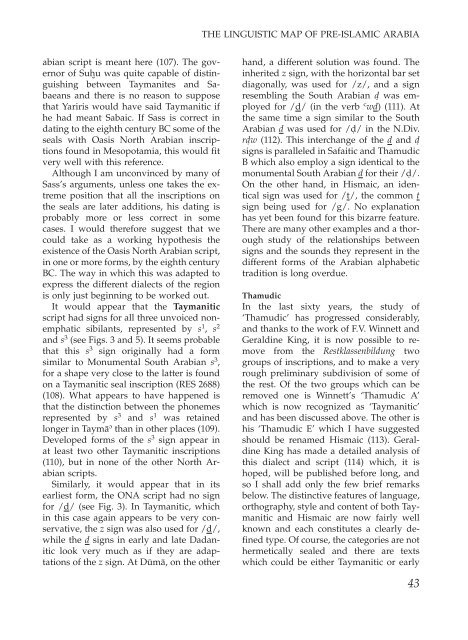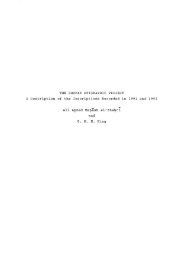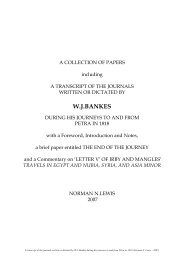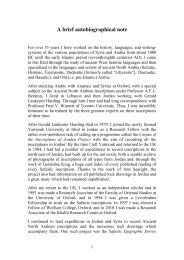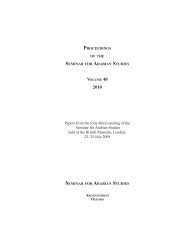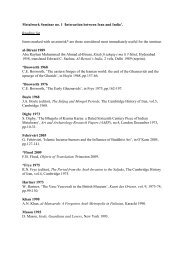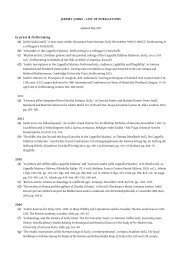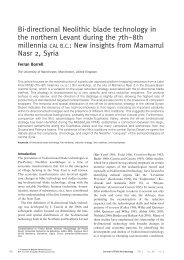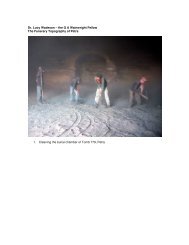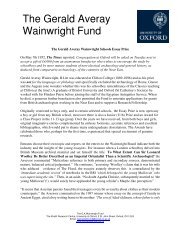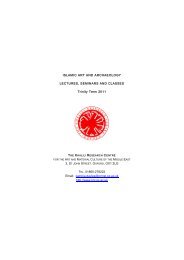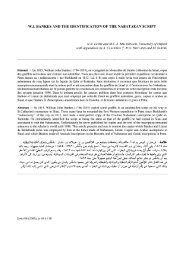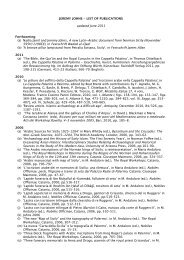Reflections on the linguistic map of pre-Islamic Arabia - Khalili ...
Reflections on the linguistic map of pre-Islamic Arabia - Khalili ...
Reflections on the linguistic map of pre-Islamic Arabia - Khalili ...
You also want an ePaper? Increase the reach of your titles
YUMPU automatically turns print PDFs into web optimized ePapers that Google loves.
abian script is meant here (107). The governor<br />
<strong>of</strong> Suh8 u was quite capable <strong>of</strong> distinguishing<br />
between Taymanites and Sabaeans<br />
and <strong>the</strong>re is no reas<strong>on</strong> to suppose<br />
that Yariris would have said Taymanitic if<br />
he had meant Sabaic. If Sass is correct in<br />
dating to <strong>the</strong> eighth century BC some <strong>of</strong> <strong>the</strong><br />
seals with Oasis North <strong>Arabia</strong>n inscripti<strong>on</strong>s<br />
found in Mesopotamia, this would fit<br />
very well with this reference.<br />
Although I am unc<strong>on</strong>vinced by many <strong>of</strong><br />
Sass’s arguments, unless <strong>on</strong>e takes <strong>the</strong> extreme<br />
positi<strong>on</strong> that all <strong>the</strong> inscripti<strong>on</strong>s <strong>on</strong><br />
<strong>the</strong> seals are later additi<strong>on</strong>s, his dating is<br />
probably more or less correct in some<br />
cases. I would <strong>the</strong>refore suggest that we<br />
could take as a working hypo<strong>the</strong>sis <strong>the</strong><br />
existence <strong>of</strong> <strong>the</strong> Oasis North <strong>Arabia</strong>n script,<br />
in <strong>on</strong>e or more forms, by <strong>the</strong> eighth century<br />
BC. The way in which this was adapted to<br />
ex<strong>pre</strong>ss <strong>the</strong> different dialects <strong>of</strong> <strong>the</strong> regi<strong>on</strong><br />
is <strong>on</strong>ly just beginning to be worked out.<br />
It would appear that <strong>the</strong> Taymanitic<br />
script had signs for all three unvoiced n<strong>on</strong>emphatic<br />
sibilants, re<strong>pre</strong>sented by s 1 , s 2<br />
and s 3 (see Figs. 3 and 5). It seems probable<br />
that this s 3 sign originally had a form<br />
similar to M<strong>on</strong>umental South <strong>Arabia</strong>n s 3 ,<br />
for a shape very close to <strong>the</strong> latter is found<br />
<strong>on</strong> a Taymanitic seal inscripti<strong>on</strong> (RES 2688)<br />
(108). What appears to have happened is<br />
that <strong>the</strong> distincti<strong>on</strong> between <strong>the</strong> ph<strong>on</strong>emes<br />
re<strong>pre</strong>sented by s 3 and s 1 was retained<br />
l<strong>on</strong>ger in Taymā $ than in o<strong>the</strong>r places (109).<br />
Developed forms <strong>of</strong> <strong>the</strong> s 3 sign appear in<br />
at least two o<strong>the</strong>r Taymanitic inscripti<strong>on</strong>s<br />
(110), but in n<strong>on</strong>e <strong>of</strong> <strong>the</strong> o<strong>the</strong>r North <strong>Arabia</strong>n<br />
scripts.<br />
Similarly, it would appear that in its<br />
earliest form, <strong>the</strong> ONA script had no sign<br />
for /d/ (see Fig. 3). In Taymanitic, which<br />
in this case again appears to be very c<strong>on</strong>servative,<br />
<strong>the</strong> z sign was also used for /d/,<br />
while <strong>the</strong> d signs in early and late Dadanitic<br />
look very much as if <strong>the</strong>y are adaptati<strong>on</strong>s<br />
<strong>of</strong> <strong>the</strong> z sign. At Dūmā, <strong>on</strong> <strong>the</strong> o<strong>the</strong>r<br />
THE LINGUISTIC MAP OF PRE-ISLAMIC ARABIA<br />
hand, a different soluti<strong>on</strong> was found. The<br />
inherited z sign, with <strong>the</strong> horiz<strong>on</strong>tal bar set<br />
diag<strong>on</strong>ally, was used for /z/, and a sign<br />
resembling <strong>the</strong> South <strong>Arabia</strong>n dw was employed<br />
for /d/ (in <strong>the</strong> verb c wd) (111). At<br />
<strong>the</strong> same time a sign similar to <strong>the</strong> South<br />
<strong>Arabia</strong>n d was used for /dw / in <strong>the</strong> N.Div.<br />
rdw w (112). This interchange <strong>of</strong> <strong>the</strong> d and dw<br />
signs is paralleled in Safaitic and Thamudic<br />
B which also employ a sign identical to <strong>the</strong><br />
m<strong>on</strong>umental South <strong>Arabia</strong>n d for <strong>the</strong>ir /dw /.<br />
On <strong>the</strong> o<strong>the</strong>r hand, in Hismaic, an identical<br />
sign was used for /t/, <strong>the</strong> comm<strong>on</strong> t<br />
sign being used for /g/. No explanati<strong>on</strong><br />
has yet been found for this bizarre feature.<br />
There are many o<strong>the</strong>r examples and a thorough<br />
study <strong>of</strong> <strong>the</strong> relati<strong>on</strong>ships between<br />
signs and <strong>the</strong> sounds <strong>the</strong>y re<strong>pre</strong>sent in <strong>the</strong><br />
different forms <strong>of</strong> <strong>the</strong> <strong>Arabia</strong>n alphabetic<br />
traditi<strong>on</strong> is l<strong>on</strong>g overdue.<br />
Thamudic<br />
In <strong>the</strong> last sixty years, <strong>the</strong> study <strong>of</strong><br />
‘Thamudic’ has progressed c<strong>on</strong>siderably,<br />
and thanks to <strong>the</strong> work <strong>of</strong> F.V. Winnett and<br />
Geraldine King, it is now possible to remove<br />
from <strong>the</strong> Restklassenbildung two<br />
groups <strong>of</strong> inscripti<strong>on</strong>s, and to make a very<br />
rough <strong>pre</strong>liminary subdivisi<strong>on</strong> <strong>of</strong> some <strong>of</strong><br />
<strong>the</strong> rest. Of <strong>the</strong> two groups which can be<br />
removed <strong>on</strong>e is Winnett’s ‘Thamudic A’<br />
which is now recognized as ‘Taymanitic’<br />
and has been discussed above. The o<strong>the</strong>r is<br />
his ‘Thamudic E’ which I have suggested<br />
should be renamed Hismaic (113). Geraldine<br />
King has made a detailed analysis <strong>of</strong><br />
this dialect and script (114) which, it is<br />
hoped, will be published before l<strong>on</strong>g, and<br />
so I shall add <strong>on</strong>ly <strong>the</strong> few brief remarks<br />
below. The distinctive features <strong>of</strong> language,<br />
orthography, style and c<strong>on</strong>tent <strong>of</strong> both Taymanitic<br />
and Hismaic are now fairly well<br />
known and each c<strong>on</strong>stitutes a clearly defined<br />
type. Of course, <strong>the</strong> categories are not<br />
hermetically sealed and <strong>the</strong>re are texts<br />
which could be ei<strong>the</strong>r Taymanitic or early<br />
43


